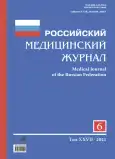Влияние шумовой нагрузки при использовании аудионаушников на психофизиологическое состояние лиц молодого возраста
- Авторы: Мартюшева В.И.1
-
Учреждения:
- Ижевская государственная медицинская академия
- Выпуск: Том 27, № 6 (2021)
- Страницы: 555-560
- Раздел: Организация здравоохранения и общественное здоровье
- URL: https://journals.rcsi.science/0869-2106/article/view/63812
- DOI: https://doi.org/10.17816/0869-2106-2021-27-6-555-560
- ID: 63812
Цитировать
Аннотация
Обоснование. Каждый современный человек, особенно жители городов и мегаполисов, ежедневно подвергается воздействию большого количества негативных факторов. Одним из самых значительных факторов является шум и громкие звуки. Помимо индустриального шума, большое количество людей добровольно повышают шумовую нагрузку, негативно влияющую не только на слуховую функцию, но и на психоэмоциональное и психофизиологическое состояние прослушиванием музыки через наушники. Кроме непосредственного воздействия на орган слуха человека громкие звуки влияют на центральную нервную систему, различные отделы головного мозга, изменяют нормальные процессы высшей нервной деятельности и приводят к нарушению когнитивных функций.
Цель исследования — изучение влияния использования различных портативных электронных устройств, оснащенных наушниками на психофизиологическое состояние лиц молодого возраста.
Материалы и методы. Исследование проводилось в 2018–2019 годах на базе кафедры гигиены Ижевской государственной медицинской академии. В анкетировании приняли участие 440 учащихся школ и вузов в возрасте 10–22 лет. Все респонденты были разделены на 2 группы в зависимости от использования наушников. Анкетирование проводилось с использованием разработанной анкеты-опросника, состоящей из 24 вопросов с заранее сформулированными ответами.
Результаты. Негативные психофизиологические проявления, а также нарушения когнитивных функций головного мозга наблюдаются среди лиц, регулярно использующих наушники, соответственно в 2,6 и 3,8 раза чаще, чем у тех учащихся, которые не используют аудионаушники в повседневной жизни. Высокий уровень негативных психофизиологических проявлений и нарушений когнитивных функций, выявленный в проведенном исследовании, объясняется использованием аудионаушников на громкости, значительно превышающей нормальные значения.
Заключение. Ежедневное неконтролируемое использование портативных электронных устройств, оснащенных наушниками, оказывает негативное влияние не только на психофизиологическое состояние, но и на когнитивные функции мозга лиц молодого возраста.
Ключевые слова
Полный текст
Открыть статью на сайте журналаОб авторах
Валентина Игоревна Мартюшева
Ижевская государственная медицинская академия
Автор, ответственный за переписку.
Email: tajraa1991@mail.ru
ORCID iD: 0000-0001-9517-377X
SPIN-код: 8687-1674
Scopus Author ID: 57209320101
аспирант кафедры гигиены
Россия, 426281, Ижевск, ул. Коммунаров, д. 281Список литературы
- Старкова Л.Н., Пихтилева Н.А., Трусова А.С. Формирование здорового образа жизни студентов-медиков через информированность и вовлеченность в исследование // Современная наука: актуальные проблемы теории и практики. Серия: естественные и технические науки. 2019. № 12. С. 173–178.
- Васильев А.В. Шумовая безопасность урбанизованных территорий // Известия Самарского научного центра Российской академии наук. 2014. Т. 16, № 1. С. 299–305.
- Левина Ю.В., Кудеева Я.Ю., Ибрагимов Ш.И. Влияние внешних факторов на состояние слуховой функции студентов, живущих в мегаполисе // Вестник оториноларингологии. 2013. № 5. С. 40–43.
- Serra M.R., Biassoni E.C., Richter U., et al. Recreational noise exposure and its effects on the hearing of adolescents. Part I: An interdisciplinary long-term study // International Journal of Audiology. 2010. Vol. 44, N 2. P. 65–73. doi: 10.1080/14992020400030010
- Biassoni E.C., Serra M.R., Richter U., et al. Recreational noise exposure and its effects on the hearing of adolescents. Part II: Development of hearing // International Journal of Audiology. 2009. Vol. 44, N 2. P. 74–85. doi: 10.1080/14992020500031728
- Zhao F., Manchaiah V.K.C., French D., Price S.M. Music exposure and hearing disorders: An overview // International Journal of Audiology. 2009. Vol. 49, N 1. P. 54–64. doi: 10.3109/14992020903202520
- Берест А.Ю., Красненко А.С. Влияние регулярного использования аудиоплееров с наушниками на слуховую функцию лиц молодого возраста // Российская оториноларингология. 2013. № 1. С. 32–35.
- Загорянская М.Е., Румянцева М.Г., Дайняк Л.Б. Возможности ранней медико-социальной реабилитации взрослых с нарушениями слуха // Материалы научно-практической конференции «Проблемы реабилитации в оториноларингологии». Самара: Перспектива; СамГМУ, 2003. С. 116–117.
- Отвагин И.В. Эпидемиологические аспекты нарушения слуха у лиц трудоспособного возраста Центрального федерального округа // Вестник оториноларингологии. 2004. № 5. С. 33–35.
- Аманбеков У.А., Газизова А.О. Влияние экопроизводственных факторов на орган слуха // Гигиена труда и медицинская экология. 2015. Т. 47, № 2. С. 3–16.
- Остапкович В.Е., Брофман А.В. Профессиональные заболевания ЛОР-органов. Москва: Медицина, 1982.
- Худякова Н.Л. Теория и методика воспитания, ориентированного на развитие ценностного мира человека: учебное пособие. Челябинск: ЧелГУ, 2008.
- Echalier M., Wood C., Mehta P., et al. Hearing loss and other long-term conditions. Joining up. 2016. [дата обращения: 06.04.2022]. Доступ по ссылке: https://rnid.org.uk/wp-content/uploads/2020/05/Joining-Up-long-term-conditions-report.pdf.
- Дорофеева С.Г., Шелухина А.Н., Тертерян Л.И., и др. Влияние шума на здоровье населения // Научный альманах. 2016. № 12-2. С. 282–285. doi: 10.17117/na.2016.12.02.282
- Васильев А.В. Акустическая экология города: учебное пособие для студентов вузов. Тольятти: Федеральное агентство по образованию, Тольяттинский гос. университет, 2007.
- Васильев А.В., Розенберг Г.С. Мониторинг акустического загрязнения селитебной территории г. Тольятти и оценка его влияния на здоровье населения // Безопасность в техносфере. 2007. № 3. С. 9–12.
- Иванов Н.И., Никифоров А.С. Основы виброакустики: Учебник для вузов. Санкт-Петербург: Политехника, 2000.
- ГОСТ 12.1.003-2014 Система стандартов безопасности труда. Шум. Общие требования безопасности. Москва: Стандартинформ, 2014.
- Спиридонова Ю.А., Макарова Б.А. Шум и его влияние на человека // Национальные приоритеты России. 2013. № 2. С. 68–69.
- Панкова В.Б., Лецкая О. А. Медицинская и социальная реабилитация лиц с нарушениями слуха от производственного шума // Вестник оториноларингологии. 2019. Т. 84, № 2. С. 8–12. doi: 10.17116/otorino2019840218
- Гараева Х.Р. Акустический дискомфорт в городской среде (на примере городов Баку и Астрахань) // Вестник астраханского государственного технического университета. 2010. № 1. С. 88–95.
- Девятловский Д.Н. Влияние шумового воздействия на здоровье человека // Актуальные проблемы лесного комплекса. 2010. № 27. С. 55–57.
- Андреева-Галанина Е.Ц., Алексеев С.В., Кадыскина Е.Е., Суворов Г.А. Шум и шумовая болезнь. Москва: Медицина, 1972.
- Артамонова В.Г., Шаталов Н.Н. Профессиональные болезни. Москва: Медицина, 1996.
- WMA [Internet]. Declaration of Helsinki — ethical principles for medical research involving human subjects [дата обращения 06.04.2022]. Доступ по ссылке: https://www.wma.net/policies-post/wma-declaration-of-helsinki-ethical-principles-for-medical-research-involving-human-subjects/.
- Грибина Г.А., Илюшина Е.С., Ермолаева Е.Л., Федосеева Л.А. Влияние шумового фактора на психоэмоциональной состояние человека // Современные научные исследования и инновации. 2017. № 6. С.99. Режим доступа: http://web.snauka.ru/issues/2017/06/83679. Дата обращения: 06.04.2022.
- Ветрова Т.В. Психологические аспекты влияния низкочастотных акустических колебаний на лиц, испытывающих воздействие неблагоприятных факторов труда // Известия Российского государственного педагогического университета им. А.И. Герцена. 2007. Т. 17, № 43-2. С. 58–65.
- Бортникова С.М., Зубихина Т.В. Нервные и психические болезни. Москва: Феникс, 2014.
Дополнительные файлы







